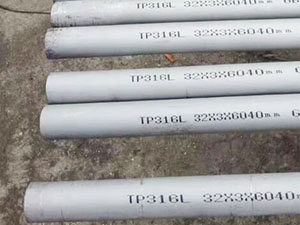UNS N08330
ASTM B 536, B 511, B 512, B 535
B 536, B 546, B 710, B 739

Forms of 330 Stainless Steel available
• Sheet
• Plate
• Bar
• Rod Coil
• Threaded bar
• Pipe
• Hex Nuts and Washers
• Expanded Metal
• Welding Wire and Coated Electrode
330 Stainless Steel Overview
330 steel is an austenitic heat and corrosion resisting alloy that offers a combination of strength and resistance to carburization, oxidation and thermal shock. This alloy was designed for applications in high temperature industrial environments where good resistance to the combined effects of carburization and thermal cycling are required, such as the heat treat industry. Carburization and oxidation resistance to about 2100° F are enhanced by the silicon content of the alloy. 330 stainless remains fully austenitic at all temperatures and is not subject to embrittlement from sigma formation. It has a solid solution composition and is not hardenable by heat treatment. The alloy's strength and oxidation resistance at high temperatures make it a useful material for industrial heating furnaces.1.
We supplies Type 330 stainless in the form of pipe, plate, sheet, bar, welding wire, welding electrode, expanded metal, hex nuts, washers, and threaded bar.
Chemical Composition, %
|
Cr
|
Ni
|
Mn
|
Si
|
P
|
S
|
C
|
Fe
|
|
17.0-20.0
|
34.0-37.0
|
2.0 Max
|
0.75-1.50
|
0.03 Max
|
0.03 Max
|
0.08 Max
|
Balance
|
What are the characteristics of 330 Stainless?
• Oxidation resistance to 2100° F
• Resistant to carburization and nitriding
• Resistant to thermal shock
• Good strength at elevated temperature
• Chloride ion stress corrosion cracking resistance
Typical applications for 330 Stainless
• Furnace containers-carburizing, carbonitriding, annealing malleablizing
• Muffles, retorts
• Bar frame heat treating baskets
• Quenching fixtures
• Radiant tubes
• Salt pots
• Furnace fans and shafts
• Conveyors
• Tube hangers for crude oil heaters adn steam boilers
• Heat exchangers
• Flares
Mechanical Properties
Room Temperature
|
Form and Condition
|
Ultimate Tensile Strength, ksi
|
.2% Yield Strength, ksi
|
Elongation %
|
|
Plate, hot rolled and Annealed
|
80-85
|
30-43
|
40-45
|
|
Sheet, cold rolled and Annealed
|
80-90
|
32-42
|
35-45
|
|
Bar, hot finished and Annealed
|
80-90
|
35-45
|
38-45
|
Values are composites for various product sizes and are not suitable for specification purposes.
Corrosion Resistance
330 steel offers a high level of corrosion resistance, particularly to oxidation, carburization and nitridation. In aqueous environments, the alloy's chromium content provides resistance to oxidizing conditions while its nickel content imparts resistance to reducing conditions. The high nickel also gives 330 good resistance to chloride-ion stress- corrosion cracking.
Fabrication with Stainless 330
Stainless Steel 330 is readily fabricated by standard commercial procedures. In comparison to carbon steel, stainless steels are tougher and tend to work harden rapidly. Alloy 330's rate of work hardening is comparable to austenitic stainless steels.
Stainless 330 can be welded using conventional welding processes.
ASTM Specifications
|
Plate
|
Sheet
|
Bars
|
Smls Pipe
|
Wld Pipe
|
Wld Tube
|
|
B536
|
B536
|
B511, B512
|
B535
|
B546, B710
|
B739
|






